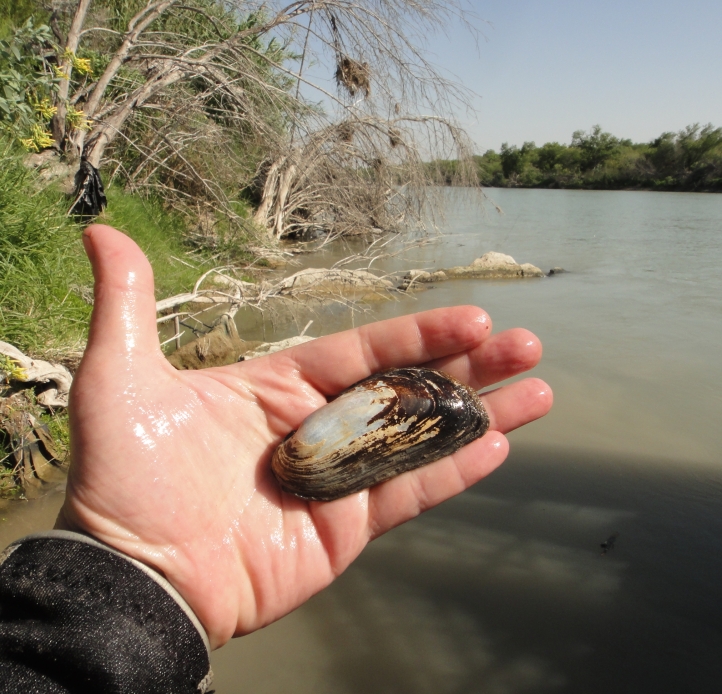
Great Lakes Center Newsletter: Issue 12
April 16, 2018
The Great Lakes Center is pleased to release the spring issue of our newsletter. This issue focuses on species spotlights: the Texas hornshell (Popenaias popeii), a unionid mussel that we had a part in getting listed as an endangered species; slender false brome (Brachypodium sylvaticum), an invasive plant that WNY PRISM lists as a high-priority early detection species; and the pawpaw (Asimina triloba), a native fruit tree recently donated to the campus. Also, we feature the new GLES 4+1 pathway, the demolition of the Science Building, and some of our recent outreach efforts.
Texas hornshell listed as an endangered species
by Lyubov Burlakova
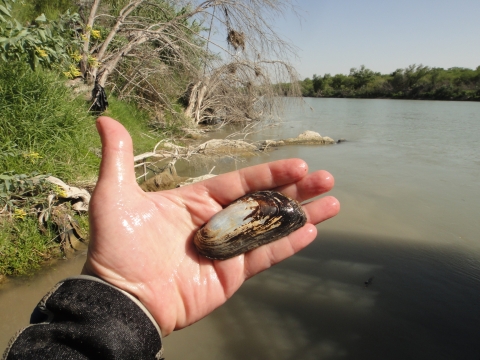
After almost a decade of delay, the Texas hornshell (Popenaias popeii) has been listed as an endangered species. It wasn’t supposed to take this long. In 2008, the ongoing process of listing the species was halted when we found a previously undescribed population of the mussels in the Rio Grande.
The Texas hornshell is a unionid mussel endemic to the Rio Grande. It was first described by the American conchologist Isaac Lea in 1857 from the Devils River in Texas and the Río Salado in Mexico. Since the mid-1970s, no live Texas hornshells had been found in the Rio Grande drainage in Texas, and the only known population persisted in a small river in New Mexico. In 2008, Alexander Karatayev, Tom Miller (Laredo Community College), and I were doing a state-wide survey of unionid mussels in Texas when we found a few live Texas hornshells in the Rio Grande. We felt lucky, but little did we know that our finding of a handful of mussels would halt the process for the endangered species listing!
To assess the degree of species endangerment for any species, we need reliable and quantitative measures of how large their populations are now and historically. However, lack of information on mollusc distribution range and population size greatly hampers the assessment of their conservation status. As a result, mussel species may become rare, endangered, and even extinct before the first population assessment is conducted, and this is especially true for endemic species, which have a limited range restricted to remote regions with difficult access.
In North America, three quarters of all freshwater mollusc species are considered imperiled or extinct, which is a higher rate than fish (39%) or crayfish (48%) species. Globally, molluscs represent 42% of all extinct animals and 25% of those critically endangered. Yet less than 10% of all molluscs have been evaluated for extinction risks, compared to 100% of mammals and birds. This lack of attention is remarkable because the vanishing molluscs constitute a large part of biological diversity in threatened freshwater ecosystems and provide important ecological functions and services.
After our discovery, the U.S. Fish and Wildlife Service funded our surveys to estimate the size of the Texas hornshell population in Texas. Mussel hunting is most successful when the water level is low, often in March, but during that time it is passable only by a kayak. Our surveys would have required months of paddling, so we decided to use an airboat. This was our adventure time! We visited amazing places on the Rio Grande where few people have been. We quickly figured out that in this flash flood-prone river, where the water level can rise by dozens of feet overnight, mussels find flow refuges hiding underneath large rocks and ledges. We also started a four-year mark and recapture study near Laredo, gluing little tags to mussels so we could count how many of them were recaptured, to estimate their growth, and document changes in the population. On the third day of marking, we ran out of tags! Brian Lang, our colleague from New Mexico, asked me why I only purchased 200. I thought it would be a waste of money to buy more since less than 200 mussels had ever been found!
Because of the mark-recapture study, we started to realize that the population above Laredo was larger than anticipated, although it must have been much larger historically. The habitat for the Texas hornshell has shrunk since the Rio Grande in Texas is now much smaller and drier due to over-withdrawal of water, and since these sensitive molluscs cannot withstand the water pollution below Laredo or the large impounded areas of the Amistad and Falcon reservoirs. Calculating the available habitat was not an easy task: it required making many assumptions about historical densities and distribution, and the GIS expertise of Mary Perrelli (Geography and Planning). After months of calculations and several revisions, we found that the total length of the river populated by this mussel has declined by 75%, and the total Texas hornshell population size has declined by 72%. The remaining population of this species in the Rio Grande is fragmented, with a single 190 km stretch still supporting high densities. The species has been extirpated from two Rio Grande tributaries.
Our paper was published in 2015, right in time for the final species assessment. On February 9, 2018, the Texas hornshell was listed as an endangered species. Now the species and its habitat will finally have federal protection. We are very happy that we have contributed to the conservation of this endemic species. The protection of the Texas hornshell will also mean the protection of many other rare species in the Rio Grande.
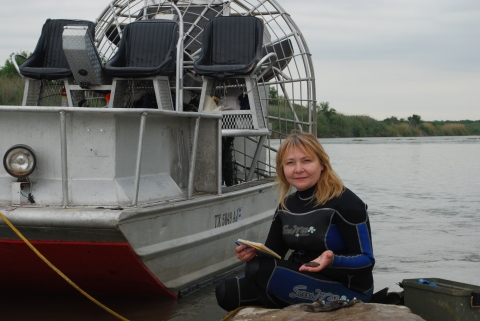

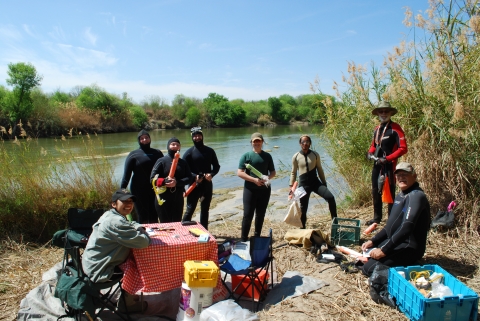
Invasive species spotlight: Slender false brome
by Brittany Hernon
WNY PRISM has been awarded $300,000 from the EPA through the Great Lakes Restoration Initiative (GLRI) to establish the Great Lakes Slender False Brome Working Group.
Slender false brome (Brachypodium sylvaticum) is an invasive species of grass which reproduces rapidly by seed to form dense clumps, creating monocultures that can overtake an area, outcompeting native vegetation and reducing biodiversity. It was initially identified in Oregon and has now spread throughout the Pacific Northwest and into Canada. In 2009, it was identified in New York and is currently found in Genesee, Wyoming, Onondaga, Tompkins, and Dutchess Counties. While it is unknown how this species was introduced to our region, WNY PRISM has identified slender false brome as a high-priority early detection species. This project will allow us to address the threat posed by slender false brome within the Great Lakes Basin by increasing awareness and coordinating management efforts.
Slender false brome grows in a wide variety of habitats, from open grasslands to forest understories, and areas with various amounts of sunlight and disturbance. It appears that a limiting factor may be soil moisture; it doesn’t like extremes in wet or dry. A component of this project is to develop a habitat suitability model to help focus survey efforts on areas most likely to be invaded. As more is learned about environmental factors that influence this species’ distribution, the habitat suitability model will become more effective at predicting areas of potential infestations.
Surveys for slender false brome will be conducted within the Great Lakes Basin of New York this summer. In addition to the presence/absence of slender false brome, data will be collected on other invasive species present, overstory cover, soil moisture, disturbance type and severity, and habitat type. Three interns will conduct surveys in different geographic areas: in and around Onondaga County, near Syracuse; roads, trails, and rights-of-way near known infestations in Wyoming and Genesee Counties; and natural areas in Western New York that were unexplored during previous survey efforts. Another intern will focus on GIS habitat suitability modeling and education and outreach.
WNY PRISM will also conduct research on the comparison of four different management methods on known infestations at Letchworth State Park and Genesee County Park and Forest, and work alongside independent management efforts at Bergen Swamp. Initial plot sampling will occur in early summer to examine percent cover and density of slender false brome, native species, and invasive species. Later in the summer, infestations will be removed using manual removal, mowing, herbicide application, or a combination of mowing and herbicide treatment. Plot sampling will occur during the same time-period in 2019 to assess the success of management efforts. Slender false brome seed production will be quantified as well.
In addition, boot brush stations will be installed near populations of slender false brome to facilitate spread prevention. Hiking boots can spread the seeds of invasive species caught in mud and dirt in the treads, so cleaning boots is essential. Boot brush stations include a heavy-duty brush affixed to a sign explaining their purpose along with information about invasive species to look out for in the area. The hope is people will be curious and read the sign, then have no excuse but to use the convenient boot brush to clean off their shoes.
WNY PRISM is honored to have support from many partners on this exciting project. To learn more, please visit the WNY PRISM website.
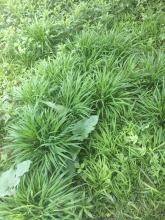
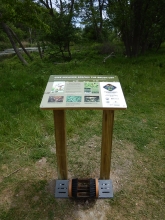
WNY PRISM continues to grow
by Andrea Locke
This year will see a large increase in staff for WNY PRISM. When WNY PRISM began operations in 2014, I was the only full-time staff member. Each summer season, WNY PRISM hired a different crew consisting of one Education and Outreach Assistant (E&O) and two or three Invasive Species Management Assistants (ISMA), as well as multiple student interns. Over the past 4 years, we have hired a total of 22 temporary staff members, many of whom have gone on to permanent positions in the field right here in western New York.
As our partnership network and corresponding project load has continued to expand, WNY PRISM has recognized the need for increased capacity. Lucy Nuessle, a former ISMA, returned to our team as a full-time Project Manager in July 2017. Lucy’s duties include supervising the seasonal crew and assisting with our early detection programs. Brittany Hernon also joined WNY PRISM as a full-time Project Manager in 2017. Brittany will be leading the recently established Great Lakes Slender False Brome Working Group.
This year, in addition to the seasonal crew consisting of 1 E&O Assistant and 2 ISMAs, we have hired 4 Slender False Brome interns and 2 Watercraft Inspection Stewards. To accommodate the growing staff and technology needs of the program, WNY PRISM recently moved our main office to a suite in the Classroom Building. The field crew will continue to be based out of the Field Station. WNY PRISM is looking forward to the opportunities our growth presents and welcomes the new additions to the team!
Career fairs at Buffalo Public Schools
by Kit Hastings
This spring, the GLC was invited to participate in Career Exploration Fairs at three of Buffalo's public schools. Kit Hastings visited North Park Middle Academy #66 on March 15th; Susan Daniel participated at Lovejoy Discovery School #43 on March 21st; and Knut Mehler will visit Marva J. Daniel Futures Preparatory School #37 in May.
Each school dedicated the full morning for their students to visit with professionals during five sessions. Between 20 and 45 presenters visited each school, from professions in science and medicine as well as musicians, bakers, martial artists, athletes, and accountants. Some presenters just gave talks about how to find careers. The goal of Buffalo Public Schools, according to Kathleen Sciolino, College and Career Readiness Coordinator, is “to help each student explore many careers, make the connection that the subjects that they are learning in school will be useful in adulthood, and find that their career dreams can be turned into a series of obtainable goals.” Students ranged from pre-K through 9th grade, and were broken up into smaller groups based on age and their expressed interests. About 1,200 students were impacted by this program this spring.
Kit and Susan told students about what it’s like to be a biologist working on the Great Lakes. We also talked about what inspired us and how we became scientists. Some of the students expressed interest in being marine biologists. Interestingly, the younger students were more engaged and willing to ask questions than the older students. Knut will have a chance to tell students about his experiences when he presents next month.
It was wonderful to talk about our careers with young people. We look forward to being involved in future Career Days with BPS.
Pawpaw trees donated to Buffalo State College
by Susan Daniel and Kit Hastings

Last fall, GLC staff Susan Daniel and Biology professor Robert Warren donated five pawpaw trees (Asimina triloba) to Buffalo State campus. Many of you may be unfamiliar with the pawpaw. It’s a small deciduous tree native to North America that produces a large edible fruit. The fruit has a greenish-blackish exterior, is usually three to six inches long, and it matures in mid- to late-September. Inside is a creamy white to yellow pulp that has been described as French custard in texture that tastes like a mixture of mango, banana, and citrus. The pawpaw tree is common in the Midwest but is classified as threatened in New York State, possibly since New York is at the northernmost part of its natural range.
The pawpaw isn’t widely cultivated for two main reasons. Even in the best of circumstances, fruit production is low. The flowers of the pawpaw tree produce a faint odor similar to rotting meat, which attracts flies and beetles instead of conventional pollinators like bees. Successful fruit production may require cross-pollination from different trees or clones; some producers resort to hand pollination. The other challenge is the fruit itself: it bruises easily and spoils quickly, so it doesn’t transport well. It’s easiest to find fresh off the tree or shipped frozen. However, the pawpaw is gaining popularity among foodies who are eagerly flocking to orchards and farmers markets in September, making ice cream or brewing beer with pawpaws, or planting it in their own yards. New varieties are being cultivated to try to overcome some of these challenges, but so far most commercial production is in southeastern Ohio.
Another feature of trees in the genus Asimina is that they are the only hosts for zebra swallowtail butterflies (Protographium marcellus). The leaves of this genus contain insecticides called acetogenins, so other insects and even most grazers leave pawpaw leaves alone due to their noxious taste and odor. The bold striped pattern of the zebra swallowtail advertises that it consumes the toxin and warns predators to stay away. This toxic property of the pawpaw leaves also makes them attractive to organic growers since there are few pests.
Susan and Robert donated the trees in collaboration with the Maud Gordon Holmes Arboretum and Steven Sypniewski, Arboretum Manager, as part of the Pleistocene Grove Project. The objective of the Pleistocene Grove is to provide a group of trees from that historic time period as a teaching opportunity about the co-evolution of trees and extinct megafauna. Besides pawpaw trees, there are Kentucky coffeetrees (Gymnocladus dioicus), a tree in the pea family that produces 5-10 inch pods of beans that can be roasted for a coffee-like drink. It is likely that both pawpaws and Kentucky coffeetrees relied on megafauna like mammoths for dispersal and seed germination. The grove is located in Upton Quad, just south of Upton Hall and adjacent to the Science building. Another contemporary tree in the grove is the honey locust (Gleditsia triacanthos), which is planted along the east side of quad near Bulger Communication Center. Honey locust trees, with a 6-8 inch pod thinner than the Kentucky coffeetree, can be dispersed by modern grazers such as cows, horses, and deer. Robert Warren has studied the distribution of honey locusts in relation to Native American settlements.
Susan was so happy to donate several pawpaw trees because there was a grove in the woods behind her childhood home. Since the opossum tend to eat all the lower hanging fruits, she and her sister would ride their horses through the woods to collect as many of the higher fruits as they could find. Many times, there was just a single fruit. The recently planted trees should reach mature age in about six years, or the fall of 2023. Whether they will produce fruit is unknown, but one can be hopeful!
Sources: Asimina triloba wiki, "This Once-Obscure Fruit Is On Its Way To Becoming PawPaw-Pawpular" NPR
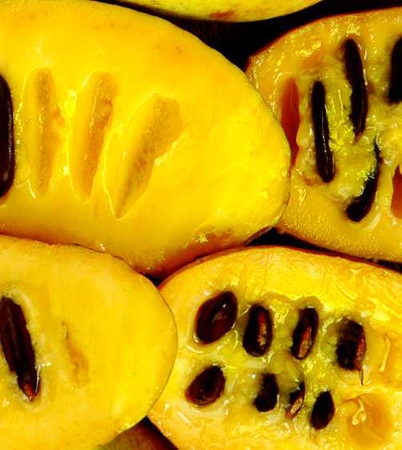
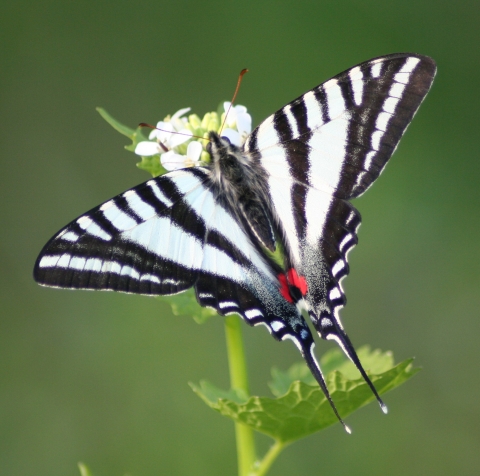
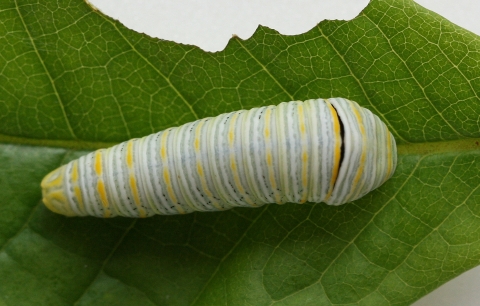

A GLES 4+1 pathway
by Kelly Frothingham
We are happy to announce a GLES M.S. 4+1 Pathway program. The 4+1 Pathway allows undergraduate students to complete course requirements for their bachelor’s degree while taking select graduate-level courses during their undergraduate study. As a result, the 4+1 Pathway provides qualified students with seamless entry to the GLES M.S. master’s degree program and an accelerated course of study toward an advanced degree.
The GLES M.S. is a Professional Science Master’s (PSM) that combines coursework in environmental science with communication strategies and project management classes and an internship experience. Students in programs leading to a bachelor’s degree in biology, chemistry, earth sciences, geography, or geology should consider this pathway to an advanced degree. For more information about the GLES M.S. 4+1 Pathway, please visit Graduate Programs or contact the GLES Program Coordinator, Dr. Kelly Frothingham.
Visiting student shadows researchers
by Susan Daniel
On March 13th, the Great Lakes Center hosted its youngest scientist yet! Thirteen-year-old Julianna Ducato, from Saint Benedict’s school in Amherst, asked to shadow GLC researchers to better understand the career field. She participated in sample identification, talked with senior researchers about the grant writing process, and viewed videos taken from Lake Ontario to assess invasive mussel populations.
Halfway through her tour, the building had a fire drill that lasted 45 minutes! To pass the time Julianna, Susan, and Lyubov talked about the ups and downs of being a scientist over some hot chocolate to warm up. Julianna’s main interests are in oceanography and marine sciences, but GLC researches may have swayed her to freshwater!
Julianna was also able to meet a graduation requirement for eighth grade students at Saint Benedict’s that includes the completion of a Career Education course and a cumulative shadowing experience with an employer. We were so happy to host Julianna, and we look forward to helping to grow her career in science.
Goodbye to the Science Building
by Kit Hastings

It’s been planned for a long time but it’s finally here. Over the next few weeks, the demolition of the Science Building will conclude, to make way for the final phase of the Science and Mathematics Complex (SAMC).
The Science Building, or Science II as it used to be known, was constructed in 1962 as an addition to the existing Science Building (Science I). Over the years, the Science Building housed many GLC labs, including the Environmental Chemistry and Toxicology Lab, as well as offices for our researchers. Our main office was most recently housed there from 2008-2012; we moved to our new offices and labs in SAMC at the beginning of 2013.
The design to build SAMC has always included the demolition of the Science Building. Phase 1 of SAMC, where the Great Lakes Center labs and offices are today, was constructed from 2009-2012. Phase 2 was the renovation of Science I; construction took place from 2013-2016. In the fall of 2017, demolition of the Science Building began. Once it’s complete, Phase 3 will commence to build the final portion of SAMC, which will connect to the atrium in SAMC and house a spherical planetarium, a café, many more classrooms, labs, and offices, and a greenhouse.
The demolition of the Science Building began with mostly internal demolition, deconstructing old furniture and equipment and removing asbestos and other hazardous materials. Gradually I watched as fences were put up, windows were removed and covered with plastic, and trees and shrubs were removed (farewell, beautiful redbud trees!). One day in early March, I noticed that the windows and walls of the old GLC office were gone and I could see directly inside! Not long after that, a crane carefully removed the glass walkway connecting Science I and Science II. By the end of March, all the walls on the exterior of the building had been removed and loads of bricks and metal were being removed. I plan on monitoring the demolition, but now that much of the skeleton has been revealed, the demolition could go quickly. You can view pictures of the demolition in a photo gallery on our website.
Questions about the SAMC construction project can be emailed to vpfm@buffalostate.edu.

